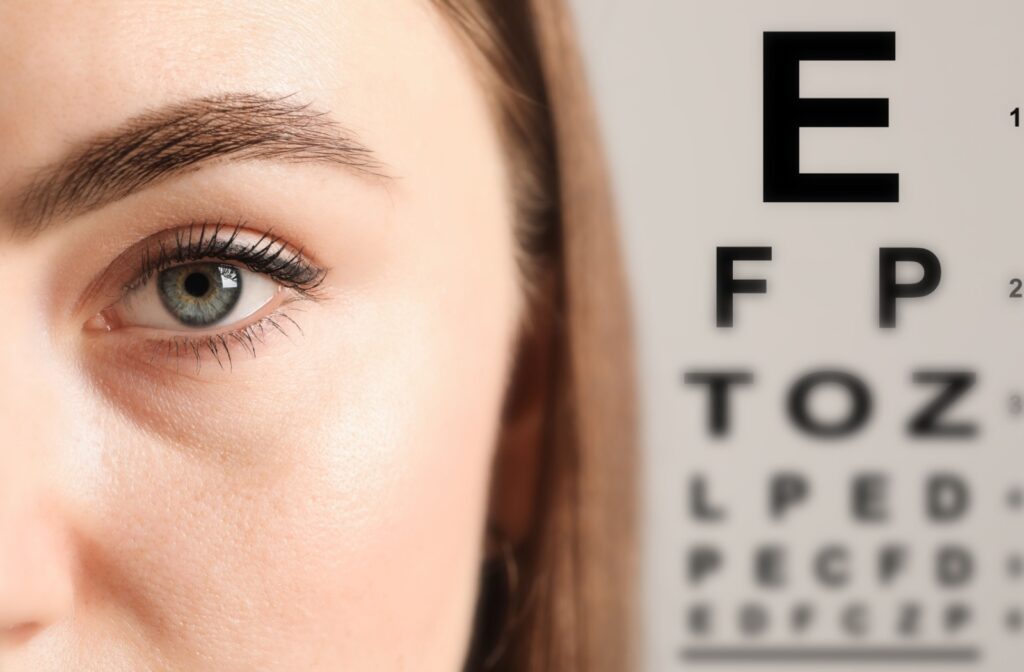Regular eye exams are one of the most effective ways to protect your vision and support your overall health. Even if your eyesight feels sharp, many eye diseases develop without exhibiting early symptoms, which is why getting routine exams is essential for early detection and peace of mind.
Eye exams help maintain good eyesight and eye health by detecting conditions such as cataracts, glaucoma, age-related macular degeneration, and diabetic eye diseases. With early diagnosis, personalized care, and expert guidance, managing conditions early and preserving your vision for the long term is often easier than you might think.
What is an Eye Exam?
An eye exam is a comprehensive evaluation of your vision and overall eye health. It involves a series of tests and assessments to check for vision conditions, common eye diseases, and risk factors that may affect your eyesight.
The recommended frequency and type of eye exams can vary depending on your age and individual risk factors. Pediatric eye exams focus on assessing development and detecting refractive errors, while adult and senior eye exams also look for signs of age-related changes that increase the risk of various eye diseases.
Systemic conditions such as diabetes can also present in the eyes, making regular diabetic eye exams crucial for early detection and management. Overall, an eye exam is an important step in maintaining good vision and supporting your overall health.
Your Guide to a Comprehensive Eye Exam
Knowing what to expect during an eye exam can take the mystery out of the process—and show you just how important regular exams are for your eye health.
A comprehensive eye exam typically includes the following steps:
- Patient history
- Visual acuity test
- Refraction assessment
- Binocular vision evaluation
- Pupil response test
- Retinal examination
- Intraocular pressure measurement

Eye Conditions Comprehensive Exams Can Help Detect
Many eye diseases don’t cause noticeable changes to your vision in their early stages. This makes them easy to overlook.
Regular, comprehensive eye exams help detect such conditions early, often before you notice any symptoms. This gives you the chance to protect your long-term vision and eye health.
Cataracts
Cataracts are a common, easily detectable condition. They occur when the naturally clear lens of the eye becomes cloudy, leading to blurred vision.
Cataracts typically develop as part of the aging process, but can also result from injury or other medical conditions. Signs and symptoms of cataracts include cloudy or blurry vision and sensitivity to light.
During an eye exam, your eye doctor can detect early signs of cataracts using specialized diagnostic tools. Cataracts can often be managed with glasses or contact lenses in their earlier stages, then with surgery as they progress.
Glaucoma
Glaucoma occurs when increased pressure in the eye damages the optic nerve. It can lead to irreversible vision loss. Known as the “silent thief of sight,” glaucoma often exhibits no symptoms until significant damage has already occurred.
During an eye exam, your eye doctor can test for glaucoma by measuring intraocular pressure with a device called a tonometer and examining the optic nerve for signs of damage. Early detection is crucial for preventing vision loss, as treatments such as medications, laser therapy, or surgery can help protect your sight.
Age-Related Macular Degeneration
Age-related macular degeneration (AMD) affects the macula, the central part of the retina, which is responsible for sharp vision. AMD comes in two forms—dry and wet. Dry AMD is more common and progresses slowly, while wet AMD is less common but can cause rapid vision loss.
During an eye exam, we can detect AMD using optical coherence tomography and fundus photography to view the back of the eye for early signs of disease. Regular eye exams are key for managing AMD and preserving your vision.
Diabetic Retinopathy
Diabetic retinopathy causes damage to blood vessels in the retina. It can cause blood vessels to swell, break, or leak fluid into the retina. If left untreated, diabetic retinopathy can cause vision loss.
Because diabetic retinopathy often shows no early symptoms, regular eye exams are crucial for patients with diabetes. During a diabetic eye exam, we’ll examine cross-sectional and digital images of the retina to look for abnormal blood vessels or hemorrhages.
Experience Elevated Vision Care in Scottsdale
Taking care of your eyes is one of the most important ways to invest in your overall well-being. Regular eye exams not only support clear, comfortable vision—they also help you stay ahead of potential concerns before they affect your quality of life. A proactive approach is key. At Eye Lab in Scottsdale, we deliver personalized, high-quality care in a stylish, welcoming environment designed with your comfort in mind. Book your next eye exam with us today and experience a truly elevated approach to vision care.





